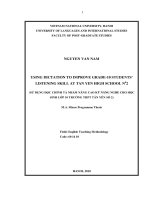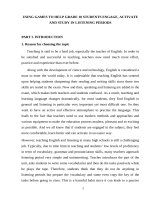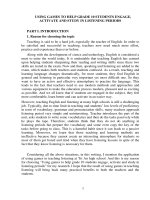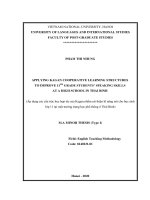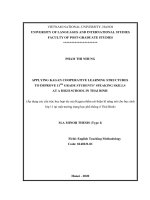Using storytelling to enhance grade 10 students listening comprehenhension at a high school an action research project
Bạn đang xem bản rút gọn của tài liệu. Xem và tải ngay bản đầy đủ của tài liệu tại đây (690.09 KB, 72 trang )
THAI NGUYEN UNIVERSITY OF EDUCATION
FACULTY OF FOREIGN LANGUAGES
––––––––––––––––––––––––––
NGUYEN DUY HUNG
USING STORYTELLING TO ENHANCE GRADE-10 STUDENTS’
LISTENING COMPREHENSION AT A HIGH SCHOOL:
AN ACTION RESEARCH PROJECT
MASTER'S THESIS OF SCIENCE IN EDUCATION
THAI NGUYEN - 2022
THAI NGUYEN UNIVERSITY OF EDUCATION
FACULTY OF FOREIGN LANGUAGES
––––––––––––––––––––––––––
NGUYEN DUY HUNG
USING STORYTELLING TO ENHANCE GRADE-10 STUDENTS’
LISTENING COMPREHENSION AT A HIGH SCHOOL:
AN ACTION RESEARCH PROJECT
English language teaching methodology
Code: 8.14.01.11
MASTER'S THESIS OF SCIENCE IN EDUCATION
Supervisor: Ph.D. NGO THI BICH NGOC
THAI NGUYEN - 2022
i
STATEMENT OF AUTHORSHIP
In this thesis, apart from the reference, the writer has presented my own work
and data. In addition, the work is submitted for this MA thesis only and has not been
published anywhere else.
No other person‘s work has been used without due acknowledgment in the
thesis. This thesis has not been submitted for the award of any degree or diploma in
any other tertiary institution.
Thai Nguyen, May 2022
Nguyen Duy Hung
ii
ACKNOWLEDGMENTS
I would like to express my deep gratitude to my supervisor who has kindly
given me valuable instructions, critical feedback, constant encouragement, and useful
suggestions. Without her guidance, this research could not be completed.
Besides, I also want to express my sincere thanks to all the lecturers from the
English Department of the University of Education, Thai Nguyen University. The
knowledge that they taught me is extremely useful for me in having a deeper
understanding of the English language and in doing the research.
In addition, I am very grateful to the school board, teachers, and students at the
high school where I conducted this research for their support and participation during
the process of doing and collecting data for my research.
Last but not least, I am thankful to my family and friends for motivating,
supporting, and encouraging me during the time of doing this research.
iii
ABSTRACT
This study investigates how tenth graders at a high school respond when
applying storytelling in teaching listening lessons and how storytelling works in
enhancing these skills. The main respondents of the study were 60 tenth grader. Pre-
and post-tests, as well as pre- and post-questionnaires, were used to collect data for the
analysis. The findings of the study showed that storytelling could help in improving the
students‘ attitude toward listening and enhancing their listening skills. Based on the
results of the research, implications for teachers, students, and institutions were
recommended by the researcher. In addition, suggestions for further research were also
provided.
iv
TABLE OF CONTENTS
The Information of the Study................................................................................ i
Table of Contents ................................................................................................ iv
Lists of tables and figures ...................................................................................... v
CHAPTER 1. INTRODUCTION ........................................................................ 1
1.1 Rationale ........................................................................................................... 1
1.2. Aims and Objectives ....................................................................................... 2
1.2.1. Aims of the Study ......................................................................................... 2
1.2.2. Objectives ...................................................................................................... 2
1.3. Scope of the Study ........................................................................................... 2
1.4. Research Questions ......................................................................................... 2
1.5. Significance of the Study ................................................................................ 3
CHAPTER II: LITERATURE REVIEW............................................................ 4
2.1. Theoretical background.................................................................................. 4
2.1.1. What is listening? ......................................................................................... 4
2.1.2. The importance of listening skill................................................................. 5
2.1.3. Listening problems....................................................................................... 5
2.1.3.2. Linguistic Features .................................................................................... 6
2.1.3.3. The Speaker ................................................................................................ 6
2.1.3.4. The Listener ................................................................................................ 6
2.1.3.5. The Physical Setting................................................................................... 7
2.1.4. Teaching listening......................................................................................... 7
2.1.5. Storytelling.................................................................................................... 11
2.1.5.1. Definition of storytelling ............................................................................ 11
2.1.5.2 Storytelling model........................................................................................ 12
2.1.5.3 The positive impacts of storytelling on learning ........................................ 14
2.1.5.4. Three Participations of Storytelling .......................................................... 18
2.2. Literature Review............................................................................................ 19
CHAPTER III: RESEARCH METHODOLOGY.............................................. 21
3.1. Research design ............................................................................................... 21
3.2. Participants ...................................................................................................... 27
3.3. Data Collection Instrument ............................................................................ 28
3.3.1. Questionnaires .............................................................................................. 28
3.3.2 Tests ................................................................................................................ 29
3.4. Data collection procedure .............................................................................. 30
3.5. Data analysis .................................................................................................... 30
CHAPTER IV: FINDINGS AND DISCUSSIONS ............................................. 32
4.1 Findings ............................................................................................................ 32
4.1.1. Findings from the pre-questionnaires ....................................................... 32
4.1.1.1 Students’ attitude toward listening ............................................................ 32
4.1.1.2 Students’ difficulties in listening ................................................................ 34
4.1.1.3 Other difficulties in listening listed by students ......................................... 36
4.1.2. Findings from the post questionnaires ....................................................... 36
4.1.2.1 Students’ interest in listening after using storytelling in classes .............. 36
4.1.2.2 Students’ attention in listening after using storytelling in classes ........... 37
4.1.2.3 Students’ evaluation on the effectiveness of storytelling in improving students’
listening comprehension ........................................................................................ 38
4.1.3. Findings from the tests................................................................................. 39
4.2. Discussion ......................................................................................................... 41
4.2.1 Students’ response when applying storytelling in teaching listening lessons
.................................................................................................................................. 41
4.3.2 The effectiveness of storytelling in improving students’ listening
comprehension skills .............................................................................................. 42
CHAPTER 5: CONCLUSION ............................................................................. 44
5.1. Summary of the study .................................................................................... 44
5.2. Implications ..................................................................................................... 46
5.2.1. To teachers ................................................................................................... 46
5.2.2. To students ................................................................................................... 48
5.2.3. To institutions .............................................................................................. 48
5.3. Limitations of the study ................................................................................. 48
5.4. Suggestions for further study ........................................................................ 49
APPENDIX ............................................................................................................ x
v
TABLES LISTS OF TABLES AND FIGURES Page
Table No. 29
Table 4.1. Table Name 30
Table 4.2. Students' difficulties in listening 32
Table 4.3. Students' other difficulties in listening
Students‘ opinions on the effectiveness of storytelling in 35
Table 4.4. improving students‘ listening comprehension
Pretest and posttest average score report
FIGURES Figure Name Page
Figure No. Storytelling Pathways 13
Figure 2.1. Students‘ evaluation of the importance of listening 26
Figure 4.1. comprehension in acquiring the English language
Students‘ interest in listening lessons at school 27
Figure 4.2. Students‘ attention to listening lessons 28
Figure 4.3. A comparison of the students' interests in listening before 31
Figure 4.4. and after using storytelling in classes
A comparison of the students' attention in listening 32
Figure 4.5. before and after using storytelling in classes
A comparison of the minimum score and maximum score 35
Figure 4.6. between the pretest and posttest
1
CHAPTER I – INTRODUCTION
1.1. Rationale
Thanks to globalization and integration, English has become an indispensable
tool to connect the whole world. In every area, from business, research, etc. to daily
life, English is used worldwide. That is the reason why English proficiency has become
one of the most important criteria to consider when recruiting a candidate or promoting
an employee.
Understanding the significant role of English, the Ministry of Education has
continuously updated the textbooks so that students have modern and constructive
materials to study this international language. The new textbooks are written in order to
develop all of the four skills, listening, speaking, writing, and reading skills. However,
in the teaching process, the author realizes that students encounter a lot of difficulties
practicing listening skills.
In general, students cannot recognize some words due to their mispronunciation.
Intonation is also a barrier for them to understand. Nevertheless, among the reasons,
demotivation is the main cause of unimproved listening skills. At school, teachers have
to follow the curriculum; therefore, listening is taught in a traditional way. That means
students learn listening lessons passively. When the teachers play the recordings, they
listen and do the tasks in the textbooks. According to my observation, the majority of
students are not eager to learn listening lessons. Therefore, they just try to fulfill the
tasks because they follow their teacher‘s instructions. The passive learning style causes
demotivation among students, resulting in poor listening skills. While listening is one
of the most important skills for learners, most students find it hard to make progress.
As a teacher, this matter has been my concern for a long time. That is the reason
why I have looked for a lot of materials to find ways to get my students involved in
listening lessons. I have found that storytelling can be a good way to improve the
listening skills of students in general and my students at a high school in particular.
2
Storytelling is interesting not only because of the pictures in it but also because the
content of every stage in the story conveys meaningful thought and feeling in which
the learners of English expect to get the knowledge and the message behind the story
(Brewster, 1991). In addition, storytelling can draw students‘ attention and interest to
the lessons. Storytelling is a social experience because it connects a teller and a listener
(Smyth, 2005).
Although storytelling can shed light on the process of teaching and learning
listening lessons, it is still necessary to have a formal study in this matter to collect
students‘ feedback so that it can be applied synchronously and effectively. Therefore,
the author would like to conduct the study ―Using Storytelling to Enhance Grade-10
Students‘ Listening Comprehension at a High School: An Action Research‖.
1.2. Aims and Objectives
1.2.1. Aims of the Study
- The study aims to investigate how tenth graders at a high school respond when
applying storytelling in teaching listening lessons and how storytelling works in
improving their listening comprehension skill.
1.2.2. Objectives
- Determining the response of students when applying storytelling in teaching
listening lessons.
- Identifying how storytelling works in improving their listening comprehension
skills.
1.3. Scope of the Study
- The study focused on sixty 10-grade students at a high school, who were
divided into two groups, experimental and controlled groups. Each group has 30
students.
1.4. Research Questions
3
- Do the students positively respond to the application of storytelling in teaching
listening lessons?
- To what extent does storytelling work in improving students‘ listening
comprehension skills?
1.5. Significance of the Study
This study will have specific guidelines on how storytelling can improve students‘
listening comprehension skills and how students respond when applying storytelling in
the classroom. Therefore, the study can be a guideline for applying storytelling in
listening lessons. Besides, it can be a good source of reference for both teachers and
students in the process of teaching and improving listening skills.
4
CHAPTER II: LITERATURE REVIEW
2.1. Theoretical background
2.1.1. What is listening?
Listening, according to Howatt and Dakin (1974), is the ability to identify and
understand what others are saying. This includes comprehending a speaker‘s
pronunciation, grammar, vocabulary, accent and grasping his meaning.
Willis (1981:134) identifies the ―enabling skills‖ of listening, which are:
• predicting what people are going to talk about
• guessing at unknown words or phrases without panicking
• using one‘s own knowledge of the subject to help one understand
• identifying relevant points; rejecting irrelevant information
• retaining relevant points (note-taking, summarizing)
• recognizing discourse markers, e.g., Well; Oh, another thing is; Now, finally;
etc.
• recognizing cohesive devices, e.g., such as and which, including link words,
pronouns, references, etc.
• understanding different intonation patterns and uses of stress, etc., which give
clues to meaning and social setting
• understanding inferred information, e.g., speakers‘ attitude or intentions.
Listening is "the active and dynamic process of attending, perceiving,
interpreting, remembering, and responding to the expressed (verbal and nonverbal),
needs, concerns, and information offered by other human beings" (Purdy, 1997).
According to Rost (2002), listening is a process of receiving what the speaker actually
says, constructing and representing meaning, negotiating meaning with the speaker and
responding, and creating meaning through involvement, imagination, and empathy.
Clark & Clark, (1977) and Brown (2001) divides listening comprehension into eight
processes, in which, the hearer, after receiving the information, assigns a literal
5
meaning to the utterance first and then assigns an intended meaning to the utterance. In
short, listening comprehension is not merely the process of a unidirectional receiving
of audible symbols, but an interactive process (Brown, 2001).
2.1.2. The importance of listening skill
In the past, listening was treated as a ―forgotten skill‖, according to Burley-
Allen (1995). In a research, Osada (2004) stated that listening was ―regarded as a
passive skill, [...] an ability that would develop without assistance‖. According to
Vandergrift, (2007), listening is the ―least researched of all four language skills‖. This
is, to some extent, considered the least important skill. However, according to
Mendelsohn (1994), listening takes up 40-50% of the total communication time; while
speaking, reading, and writing account for 25-30%, 11-16%, and about 9% respectively.
Coakley & Wolvin (1997) claims that listening is central to the lives of students
throughout all levels of educational development. Listening is the most frequently used
language skill in the classroom (Ferris, 1998). In conclusion, listening is also a
significant skill, compared to the remaining macro skills.
2.1.3. Listening problems
Yagang (1993) classifies the listening problems into four sources: the message to
be listened to, the speaker, the listener, and the physical setting. In which:
2.1.3.1. The message
It is more difficult to understand a taped message than a text message because of
the speed. If it is a text message, the receiver can read it as many times as he wants to
understand it well. However, while listening, the listeners have to process the
information in a much shorter amount of time. Besides, it is quite impolite to ask the
speakers to repeat many times.
Another reason that causes difficulties for listeners is the unfamiliar topics.
Since the listening material may consist of a variety of topics, some of them are not
6
familiar to learners. In addition, in daily communication, speakers change the topics
quite often, which makes the listeners have to well adapt to follow the conversations.
Moreover, the content is usually not well organized. Therefore, in many cases,
listeners cannot predict what speakers are going to say, whether it is a news report on
the radio, an interviewer‘s questions, everyday conversation, etc.
2.1.3.2. Linguistic Features
Daily communication is far more different from what we have learned from the
textbooks. In a real conversation, the use of liaison (the linking of words in speech
when the second word begins with a vowel, and elision (leaving out a sound or sounds)
are common. These phenomena cause difficulties for students in recognizing individual
words in the stream of speech.
Furthermore, if listening materials are made up of everyday conversation,
people sometimes do not strictly follow the grammatical rules. Some elements can be
omitted or added due to the speaking habits. In an informal conversation, the listeners
also have to deal with colloquial words and expressions or even slang.
2.1.3.3. The Speaker
―In ordinary conversation or even in much extempore speech-making or
lecturing we actually say a good deal more than would appear to be necessary in order
to convey our message. Redundant utterances may take the form of repetitions, false
starts, re-phrasings, self-corrections, elaborations, tautologies, and apparently
meaningless additions such as I mean or you know‖ (Ur, 1984:7). This redundancy can
cause more difficulties for students at lower levels.
Accents can also be the factors affecting the listening comprehension process
because students are normally trained to understand British or American English.
Therefore, if the speaker has another accent, students can find it hard to understand.
2.1.3.4. The Listener
7
Due to the limitation in communicating with native speakers, foreign-language
learners are not familiar with clichés and collocations.
According to Anderson and Lynch (1988), a lack of sociocultural, factual, and
contextual knowledge of the target language can present an obstacle to comprehension
because language is used to express its culture.
Most foreign language learners are accustomed to reading materials rather than
listening. The lack of exposure to the different kinds of listening materials can be a
challenge for them.
Since they have to encounter a lot of difficulties in practicing listening skills,
some students can be demotivated and discouraged.
2.1.3.5. The Physical Setting
Noise is a distracting factor that affects the comprehension process. Another
factor is the lack of visual and aural aids. In a classroom, the low-quality equipment
can add more difficulties for students to understand the content.
2.1.4. Teaching listening
As listening is ranked the most difficult skill by most learners, it is essential for
teachers to find effective methods and activities to help students to overcome the
challenges. Generally, listening activities are divided into three categories: pre-
listening, while-listening, and post-listening activities.
Pre-listening activities: Schema theory provides strong evidence for the
effectiveness of pre-listening activities which includes the outline for listening to the
text and teaching cultural key concepts. The listening teacher may select certain words,
difficult grammatical structures, and expressions to be explained through the discussion
about the topic, and may also ask students to predict the content or what speakers are
going to say, based on the information they have already got. Pre-listening activities
usually have two primary goals: (a) to help to activate students‘ prior knowledge, and
build up their expectations for the coming information; and (b) to provide the necessary
8
context for the specific listening task. The teacher could follow with a listening
comprehension activity, such as two people having a conversation about their daily life.
Students must answer true or false questions based on the previous listening activity.
An example of a controlled practice activity could be a drill activity that models the
same structure or vocabulary (Karakas, 2002).
While-listening activities: Listeners who participate actively in the listening
experience are more likely to construct clear and accurate meaning as they interpret the
speaker‘s verbal message and nonverbal cues. During the listening experience, students
verify and revise their predictions. They make interpretations and judgments based on
what they heard. The listening teacher may ask students to note down keywords to
work out the main points of the text. Students answer comprehension questions while
listening to the text and select specific information to complete the table provided with
the text. While-listening activities usually have some of the following purposes: to
focus students‘ comprehension of the speaker‘s language and ideas; to focus students‘
attention on such things as the speaker‘s organizational patterns; to encourage students‘
critical reactions and personal responses to the speaker‘s ideas and use of language. An
open-ended activity could follow that allows students to have the freedom to practice
listening comprehension in the class about their daily life and asking for further
information. Listening comprehension should begin with what students already know
so that they can build on their existing knowledge and skills with activities designed on
the same principle. A variation on the ―filling in the missing word listening activity
could be to use the same listening materials but to set a pair work activity where
student A and student B have the same worksheet where some information items are
missing (Karakas, 2002).
Post-listening Activities: Post-listening activities are important because they
extend students‘ listening skills. Post-listening activities are most effective when done
immediately after the listening experience. Well-planned post-listening activities offer
9
students opportunities to connect what they have heard to their own ideas and
experiences and encourage interpretive and critical listening and reflective thinking. As
well, post-listening activities provide opportunities for teachers to assess and check
students‘ comprehension, and clarify their understandings; to extend comprehension
beyond the literal level to the interpretive and critical levels. Different comprehension
questions can be assigned for students to discuss after listening, students then swap
information to complete the whole class chart, correlating what each student has heard
to arrive at the big picture. If there are any questions that remain unanswered during
the first or second listening, and after the information swap activity, the whole class
can listen to the tape again. The students will then try to find the answer to the
questions that have not been previously understood, rather than the teacher providing
the answers straight away (Karakas, 2002).
Brown (2006:2) point out that one very important idea for teaching listening is
that listening courses must make use of students‘ prior knowledge in order to improve
listening comprehension. Prior knowledge is organized in schemata (the plural form of
schema): abstract, generalized mental representations of our experience that are
available to help us understand new experiences.
Furthermore, Students obviously need both bottom-up and top-down processing
skills in listening as well. Students must hear some sounds (bottom-up processing),
hold them in their working memory long enough (a few seconds) to connect them to
each other, and then interpret what they‘ve just heard before something new comes
along. At the same time, listeners are using their background knowledge (top-down
processing) to determine meaning with respect to prior knowledge and schemata
(Brown, 2006). The bottom-up point of view looks at the process of listening as the
way to get information from the (listening) text. This approach believes that linguistic
knowledge decides whether or not the listener understands the text. Understanding of
information starts from a very low level of recognition: listening to sounds, phonemes,
10
words, and sentences; considering the structures of each sentence, as well as taking the
non-linguistic context into consideration. In the process of comprehension, listeners
may also try to guess what a speaker is saying (Brown, 2013). Buck (2013) explains
that this process of listening constitutes the sequence from audio input transferred into
phonemes (the smallest meaningful unit of sounds), recognizing words at the syntactic
level, predicting semantic contents, understanding meaning through basic linguistic
meaning, to interpreting literal meaning based on the context of communication.
Top-down approaches: In the view of a top-down approach, the schemata or
background knowledge plays an important role in the listening process. The schemata
will help the understanding of a text because the knowledge can make the listener
know what the topic is being talked about, and if the listener knows about the topic, it
will make him or her get the meaning because he or she has already known about the
topic. Buck at Nasrudin (2013), points out that in the top-down process, any kind of
knowledge to understand a text is used randomly as needed by the listener. In this way,
listeners do not rely on their understanding of words first rather than their
understanding of sentences, but they try to understand, for example, from the context.
Listeners analyze the sentences, then find out what words are important for
comprehension, until they can understand the content of the text. The problem that may
appear in listening is not the lack of skill in receiving information and using context,
but more on the ability to apply it when listening to a foreign language (Ur, 1984).
Besides, the interactive approach to listening is promoted by Brown (2001).
Based on this approach, the listening processes consist of eight steps. Firstly, the
listener processes ―the raw speech‖ and keep an ―image‖ (phrases, clauses, cohesive
markers, intonation, and stress patterns). Then he or she determines the type of speech
(e.g., conversation or speech), and interpret the message. Next, the listener deduces the
purpose of the speaker based on the types, context, and content of the speech event.
After that, the listener refers to background information (schemata) to match it with the
11
context and topic. Subsequently, the listener gives a literal meaning to the utterance.
Then, the listener transfers an intended meaning to the utterance. In the next step, the
listener decides if the information should be kept in short-term memory or long-term
memory. Finally, the listener omits the form in which the information was initially
obtained. Except for the first and the final steps of comprehension, the steps in between
are not necessarily in sequential order.
The three approaches make use of many elements for comprehension: words,
phrases, sentences, and also the context (linguistic and non-linguistics contexts of
utterances). It should be used in the teaching of listening since they are beneficial for
training to improve listening skill.
2.1.5. Storytelling
2.1.5.1. Definition of storytelling
Storytelling is an activity involving the interaction between storyteller and
audience and between an individual and the listener at a certain level (Akhyak &
Indramawan, 2013).
The National Council of Teachers of English (2005) defines storytelling as the
relating of a tale to one or more listeners, and they emphasize that it is not congruent
with simply acting out a drama or reciting a story from memory or a text, but it is the
creation of mental images of the elements of a story through voice and gesture to an
audience. And, through the telling of a story, the teller and the audience give complete
attention and engage in a learning experience.
Storytelling is also defined as the way for the students to retell stories in a
different word construction after being told the stories by the teacher (Safdarian, 2013).
According to Caine et al. (2005), storytelling is the primary way that people access,
express, and retain information and knowledge.
Other theorists believe storytelling to be synonymous with narrative inquiry,
regardless of whether it is written down or delivered orally (Denning, 2005; Heo 2003,
